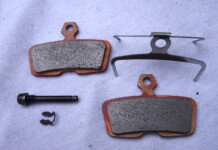By Tom Jow – Labor day has passed and I’m sorry to say it, summer is coming to a close. However, there are a couple of good things going on in September, the beginning of the fall riding season and Labor Day sales. This is the time when you can find some great deals on components to service or upgrade your bike. Maybe some drivetrain parts need to be replaced. If you’re going to replace them, might as well install better ones. Or maybe you’ve been coveting a pair of carbon wheels. You deserve them. Now, the price is right to improve the quality of your ride. What follows are what I feel are good value performance upgrades with reasons why, and what to watch out for before making the purchase.
 One component that is nearly always worth upgrading is the wheel set. Whether you ride road or mountain, having a lightweight, wheel set is a big improvement. Lighter wheels are advantageous because not only do they reduce the overall mass of the bike, they accelerate faster due to their lower rotating mass. For road riding, aerodynamics is also an important factor. If your average speed is above 15 miles per hour and your rides do not often involve long, steep climbs, an aerodynamic wheelset is worth considering. Deep dish wheels with a profile greater than 50 millimeters are pretty specialized, but many all-around wheels with a rim profile less than that are available.
One component that is nearly always worth upgrading is the wheel set. Whether you ride road or mountain, having a lightweight, wheel set is a big improvement. Lighter wheels are advantageous because not only do they reduce the overall mass of the bike, they accelerate faster due to their lower rotating mass. For road riding, aerodynamics is also an important factor. If your average speed is above 15 miles per hour and your rides do not often involve long, steep climbs, an aerodynamic wheelset is worth considering. Deep dish wheels with a profile greater than 50 millimeters are pretty specialized, but many all-around wheels with a rim profile less than that are available.
A big design change for both road and mountain bikes is the width of rims and tires. The benefit of this increased width is more comfort and better traction. For road, tires 25 millimeters wide are becoming the norm and 28 millimeter width is not uncommon. Mountain bikes, in addition to having a new plus size, are equipped more often with tires 2.3 – 2.5 inches wide. Mountain bike riders really benefit from wider rims because they reduce flex of the tire casing and square the “edge” of the tire to increase cornering traction.
When purchasing wheels, be sure to pay close attention to the type of axle required. Currently the standard of thru-axles is in a state of flux. Some road and cyclocross bikes with disc brakes started out using 15 millimeter front axles with quick-release in the rear. Some incorporated mountain bike standard rear of 12 millimeter x 142 millimeter. Now some manufacturers have decided to use a 12 millimeter front thru-axle. On the mountain bike side, there is a new axle standard called “boost.” This features a 15 millimeter x 110 millimeter front axle and 12 millimeter x 148 millimeter rear axle. There was a short time when bikes were equipped with boost front axles and standard rear axles. A wheel purchase could get confusing because many wheelsets are not sold mixed boost and not boost.
Parts that wear out are always a good target for upgrading. Weight savings and performance gains can be made by replacing the cassette and rear derailleur. For example, many mid-priced bikes are equipped with a low end, all steel cassette. These units are quite heavy. Upper end cassettes are built with an aluminum carrier with just the load carrying cog teeth being made of heavier steel. Some of the best cassettes will use aluminum or titanium for the largest cogs. If that large cog is not quite low enough, there are many companies making kits to add a larger cog to your current cassette (See https://www.cyclingwest.com/tech/mechanics-corner/how-to-do-it-yourself-1x-drivetrain-conversion/).
Be aware that cassette brands do not mix well. Campagnolo only fits Campagnolo. Operationally Shimano and SRAM cassettes are compatible but Shimano mountain cassettes do not fit the SRAM XD freehub (the part the cassette mounts to). In addition, 11 speed Shimano mountain freehub bodies are being phased out since the mountain cassette is narrower and will fit the standard road freehub body with a 2.5 millimeter spacer behind.
A part that does not really wear out, but is a good candidate for an upgrade is handlebars. The best reason to purchase a new handlebar is to customize our fit. Another reason is to improve the ride. A good carbon handlebar dampens vibration better than aluminum, thus making the ride more comfortable. It is also a good way to make our bike a little lighter. Even a good mid-level bike comes with a pretty heavy aluminum bar. Also, if the bars are heavy, the stem is probably heavy too. Similar to handlebars, upgrading the stem can both improve our fit, the quality of the ride and again, reduce the weight of the bike. When purchasing handlebars or stem, be sure to match the handlebar clamp diameter. Road bars have pretty much settled on a standard size, but mountain bikes are currently developing a new standard. Mountain bike handlebar width is important as well, not because they are too wide, but many bars have a minimum width.
For a more comprehensive mountain bike upgrade, try a 1x set-up. Removing the front derailleur and parts is a significant weight savings and also makes shifting much simpler. A 2 x 10 can easily become a 1 x 10 (Cycling Utah, June 2015). A 2 x 11 can become a 1 x 11 with just the removal of some parts and a new chainring. If you are really interested in having 12 speeds and a 50t cassette, the SRAM 1 x 11 can be upgraded to the new Eagle by purchasing a shifter, rear derailleur and cassette.
I can go on and on about upgrades. I am always wondering what is the best value for performance gain. It may sound small, 4 ounces lighter. But twice 4 ounces equals a half pound. A half pound is significant in my book. As well as making our bike lighter, we are improving our fit, our comfort, and performing regular maintenance. And with it being sale season, who doesn’t like getting a good deal on bike parts. Just be sure to take the time to find the compatible components to fit your needs and your bike.












